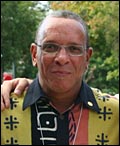
The Environmental Justice For All Tour wrapped up last Monday in Washington, D.C., where the Northeast and Southern tours united to lobby their federal representatives and gain more national attention for the environmental justice issues they had seen around the country. After seven days on the road, with stops in multiple communities each day, tour participants were tired but energized by the outpouring of support and solidarity they found along the route.
Tour participant Theodore Carrington, second vice president of the New Jersey NAACP, took a few minutes to recap the week’s events and talk about his hopes for the future of the environmental justice movement.
What were some of your goals for the tour?
For me the obvious goal was the learning process. It was a learning process for me to see the struggles that people have, the victories that people get, the determination that people have. Also, as a link. People need to know that there are other people concerned for them, even though you might be in a little town.
I remember one town in particular, Endicott, N.Y. There was a presentation, and the guy [who had spoken to the tour] actually got on the tour bus after the presentation … He showed me a picture of his house in relation to a giant corporation. And it still hadn’t dawned on me exactly what he was saying, until we stopped at his house. Then I understood exactly what he was saying, because the presentation earlier in the day did not really address what he was talking about. During the presentation, two of the speakers were from the tour bus, including myself, and we talked about poor people, we talked about the lack of communication with these people, the ones who were being affected the most. Then I understood the look in his eyes as he looked at me, saying “Hear me out.” And then it just became overwhelming for me to see what he was going through, living over top of a giant PCE spill, his house has to have ventilators to ventilate his home from the vapors underneath his home.
I guess it’s one thing to hear somebody talk about it, and another thing to actually go see what it is they’re talking about.
I don’t think the presentation was really addressing him, and that’s what he was so frustrated about. They were talking about what the government has done for some things, and what certain groups had done for some things, but he was saying “What about me, a person who is being affected, my health is probably being affected, and no one is even addressing it? No one is even talking about it, no one is even recognizing it.” That’s really the issue that I see, that in America, there are really so many environmental issues where people are bypassing the human impact, what it’s doing to people’s lives, what it’s doing to generations of people. That’s the real story. You know, the environment has problems. I like to use global warming as an example. There is a problem of global warming, and certainly we’re seeing some of the effects of it, and probably in a few more years it will be much more disastrous than it is now. But we’re talking about human impact right this second — babies born sick because of environmental factors, children can’t learn in school because of environmental factors. That’s not in the future. That’s not tomorrow. That’s not next week. This is now, as we speak.
I found the Endicott story particularly interesting because I went to school maybe 20 minutes down the road from there, and I’d never heard anything about any of that.
That’s because it’s swept under the rug. People don’t want to talk about it. And again, when you’re talking about poor people, their issues don’t come to the surface. The ironic thing about it is, this is the very drag on the nation’s economy, because we’re not paying attention to an issue that we can do something about. If we’re talking about health care and the high cost of health care, well you know, if you would eliminate some of the problems so that people weren’t getting sick because of the environment, that might cut down on health care. But why talk sensibly like that?
Sticking your finger in the dam instead of fixing it?
Instead of fixing it, right. And you know, corporations understand the bottom line. I understand their need to make money – corporations should make money, but not at human expense. They have to figure out a way to make money and not make people sick. That’s just not right.
What were some of the experiences on the tour that most affected you?
One of them was the gentleman in the community in Endicott. That was just outrageous … This is something that happened back in ’79 and the effects of it are still there. Or a gentleman up in Buffalo, who said that when he was a youngster, he never knew what color the snow was going to be. He lived near a plant that made that famous red dye that they put in m&m’s. That red dye, they pretty much stopped making that color of red dye for m&m’s for a long time, because that red dye was unhealthy. So you had oddball snow. I’m trying to imagine how you would even think about that.
And also near Buffalo, people lived near a quarry that wanted to expand, but already people who lived near the quarry were suffering from the effects of the dust, and they had the dynamite blasts that would shake your homes, the foundations of your homes. Buildings cracked because of the quarry, and this is without them even expanding. And you have the lake up in Onondaga, one of the most poisonous lakes in the world! We were outside the bus, 15-20 yards from the shoreline, and it just looks like it’s a beautiful lake. But as you get closer you can see that it’s one of the most toxic bodies of water ever.
And then we drove down to Connecticut, and we were at a place where there was 50 yards between the highway and people’s homes. And there was a ceremony outside of where the people’s homes were, a ceremony to mark the fact that they were putting up a sound barrier, a ceremony where we literally had to scream at each other so we could be heard to address the audience. What makes it so bad is that it was an eight-year struggle to put up a quarter-mile sound barrier, to bring relief to people.
So, that was a frustration that I sensed, that when people look to the government for relief, it’s not there. They’re being ignored. And it’s so hard to maintain your belief in how the system works when you’re in a desperate situation and the government says, “We’ve got more important things to do.” And “We don’t believe there’s enough information here to warrant a quarter-mile piece of sound barrier.”
Sounds like the tour was pretty overwhelming. It must have been tiring.
At some points, it was on and off, on and off, on and off. One day we went from Albany to New Haven to Hartford. Each time there was some sort of activity at each place. That was a challenge. You know, you’re tired, you’re a little worn out. At the same time, when you got out [of the bus] you saw people who were interested in what you were doing. Whether you saw a lot of people or a few people, it didn’t matter. They were people who were grateful that you came by, grateful that you’re raising the level of awareness in their community, grateful that there are people out there in the struggle to bring about fair treatment for poor people and people of color.
What are some of the long-term results that you hope to see from this tour?
I’d love to see the level of awareness raised. In this country, unless it gets to news print, people just don’t see it. We need to raise the level of awareness. We need to get more people involved. As far as I’m concerned, this is the next great social issue in our country, the fact that people are getting poisoned, people are dying, and it doesn’t have to be. Early on … the environmental movement, although really concerned about the planet, didn’t really take up or has not taken up the human factor of degradation to the planet, the immediate factor. I want to save the whales, but I want to save people, too. I need to see that the more established environmental community is starting to pay more attention to those things that have human impact as the assault on the environment continues. I’d like to see that more legislators are going to be come more aware of it, especially in those communities in those areas where the pollution is so great and people are being greatly affected.
I am also hoping that communities that are not active, the communities that kind of sit down and watch TV, shake their head and say “That’s a shame” will rise up a little bit … People who are comfortable in their homes should be outraged by the fact that in this country today, there are people who are literally being poisoned.
Sounds like it was good to see the efforts coming together through this tour.
You need to see that. At the Environmental Justice Leadership Summit a couple years ago, I met people. I met Latinos and Native Americans and I met Asians and Pacific Islanders. And all of them were getting dumped on, all around the country. And I said, “Oh my goodness, this is so much more than what I thought.” And not having the opportunity to travel around, sometimes you lose a little bit of the power of interacting with people. I can put it this way — the batteries have been recharged.
Anything else you want to say about the tour?
I think the final thing I want to add is that this is something that can be done. This is something that can change. This is do-able. This is not some impossible project … People [think] because they don’t live in a community of color, or they don’t live in a poor community, they think that they’re safe from the effects of the environment, and it’s just not so. There is no color line or poverty line drawn in the sky, across the water, or a mark in the sand. It just doesn’t work that way. So while people who live closest to it are affected the most, those people who live two, three, four miles away are also being affected … America needs to know that the problems of the people in the environmental justice communities are also their problems. And until they see it that way, it’s going to continue.


